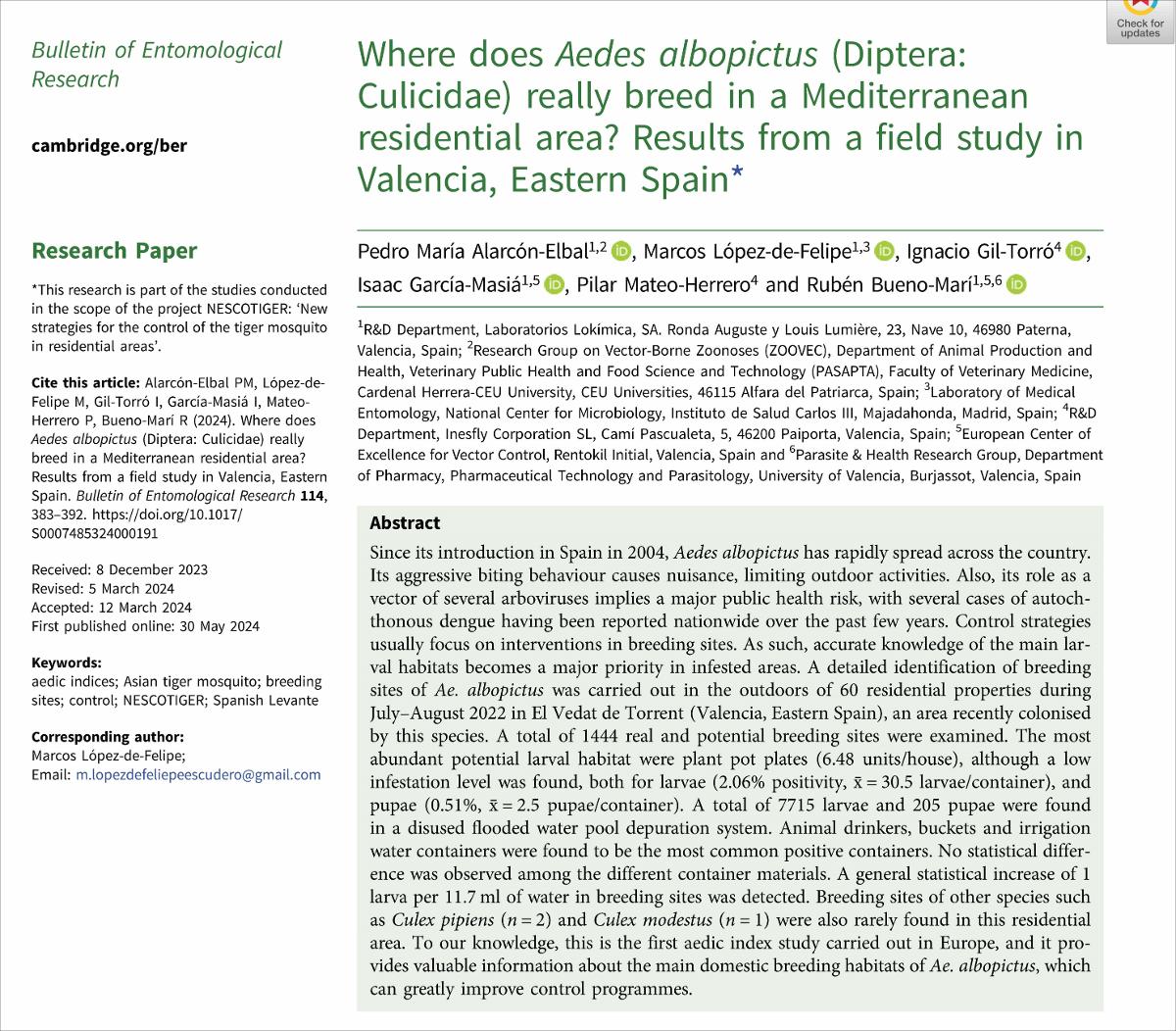Please use this identifier to cite or link to this item:
http://hdl.handle.net/10637/16396Where does "Aedes albopictus" (Diptera: Culicidae) really breed in a Mediterranean residential area?: results from a field study in Valencia, Eastern Spain

See/Open:
Where_Alarcon_BER_2024.jpg
4,38 MB
JPEG
See/Open:
Where_Alarcon_BER_2024.pdf
Restricted Access
488,31 kB
Adobe PDF
Request a copy
| Title: | Where does "Aedes albopictus" (Diptera: Culicidae) really breed in a Mediterranean residential area?: results from a field study in Valencia, Eastern Spain |
| Authors : | Alarcón Elbal, Pedro María López de Felipe, Marcos Gil Torró, Ignacio García Masiá, Isaac Mateo Herrero, Pilar Bueno Marí, Rubén |
| Keywords: | Insecto; Insects; España; Spain; Comunidad Valenciana; Community of Valencia; Transmisor de enfermedad; Disease vector; Lucha contra los insectos; Fight against insects; Control de plagas; Pest control; Control biológico; Biological control |
| Publisher: | Cambridge University |
| Citation: | Alarcón Elbal, P.M., López de Felipe, M., Gil Torró, I., García Masiá, I., Mateo Herrero, P., & Bueno Marín, R. (2024). Where does "Aedes albopictus" (Diptera: Culicidae) really breed in a Mediterranean residential area?: results from a field study in Valencia, Eastern Spain. Bulletin of Entomological Research, 114(3), 383 - 392. https://doi.org/10.1017/S0007485324000191 |
| Abstract: | Since its introduction in Spain in 2004, Aedes albopictus has rapidly spread across the country. Its aggressive biting behaviour causes nuisance, limiting outdoor activities. Also, its role as a vector of several arboviruses implies a major public health risk, with several cases of autochthonous dengue having been reported nationwide over the past few years. Control strategies usually focus on interventions in breeding sites. As such, accurate knowledge of the main larval habitats becomes a major priority in infested areas. A detailed identification of breeding sites of Ae. albopictus was carried out in the outdoors of 60 residential properties during July–August 2022 in El Vedat de Torrent (Valencia, Eastern Spain), an area recently colonised by this species. A total of 1444 real and potential breeding sites were examined. The most abundant potential larval habitat were plant pot plates (6.48 units/house), although a low infestation level was found, both for larvae (2.06% positivity, x̄ = 30.5 larvae/container), and pupae (0.51%, x̄ = 2.5 pupae/container). A total of 7715 larvae and 205 pupae were found in a disused flooded water pool depuration system. Animal drinkers, buckets and irrigation water containers were found to be the most common positive containers. No statistical difference was observed among the different container materials. A general statistical increase of 1 larva per 11.7 ml of water in breeding sites was detected. Breeding sites of other species such as Culex pipiens (n = 2) and Culex modestus (n = 1) were also rarely found in this residential area. To our knowledge, this is the first aedic index study carried out in Europe, and it provides valuable information about the main domestic breeding habitats of Ae. albopictus, which can greatly improve control programmes. |
| Description: | Este recurso no está disponible en acceso abierto por política de la editorial. Esta investigación pertenece a una serie de estudios realizados para el proyecto NESCOTIGER: "New strategies for the control of the tiger mosquito in residential areas”. |
| URI: | http://hdl.handle.net/10637/16396 |
| ISSN: | 0007-4853 1475-2670 (Electrónico) |
| Issue Date: | Jun-2024 |
| Center : | Universidad Cardenal Herrera-CEU |
| Appears in Collections: | Dpto. Producción y Sanidad Animal, Salud Pública Veterinaria y Ciencia y Tecnología de los Alimentos |
Items in DSpace are protected by copyright, with all rights reserved, unless otherwise indicated.

